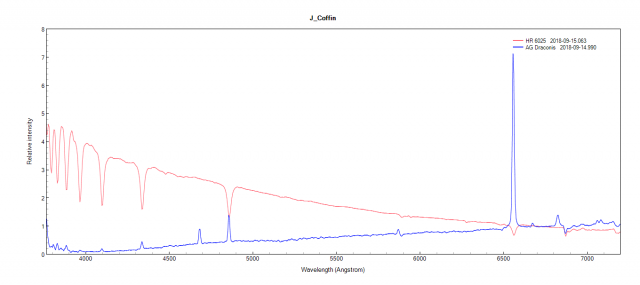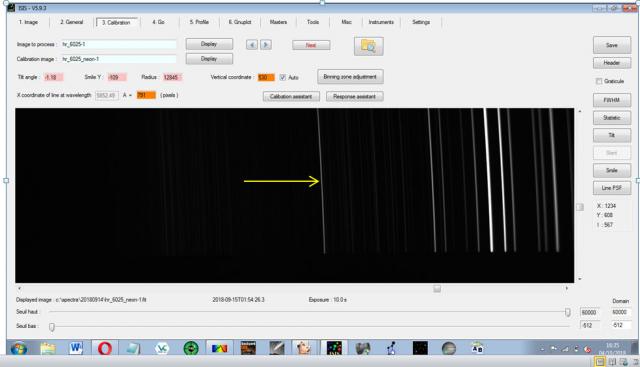Forum Replies Created
-
AuthorPosts
-
 John CoffinParticipant
John CoffinParticipantHere is the text of the ISIS report after pressing the Go button on the calibration assistant.
Extract spectral profile…
Input image : c:spectra20181028mean.fit
Y-coordinate of binning zone : 532
Binning zone width : 27
Sauve the rectified image : c:spectra20181028@.fit
Save the profile : c:spectra20181028@.dat (uncalibrated spectra)
Ok.
——————————————
Extract spectral profile…
Input image : c:spectra20181028neon5.fit
Y-coordinate of binning zone : 532
Binning zone width : 27
Sauve the rectified image : c:spectra20181028@@.fit
Save the profile : c:spectra20181028@@@@.dat (uncalibrated spectra)
Ok.
————————————————————————–
Lines search zone
| -5 | 373 | 3 |
| -5 | 384 | 3 |
| -5 | 401 | 3 |
| -4 | 428 | 4 |
| -5 | 478 | 3 |
| -3 | 584 | 5 |
| -5 | 790 | 7 |
| -5 | 809 | 7 |
| -6 | 878 | 6 |
| -5 | 929 | 7 |
| -6 | 1070 | 6 |
| -8 | 1124 | 6 |
| -10 | 1202 | 4 |
Gaussian fit on : +/-5 pixels
————————————————————————–
Reciprocical inverse dispersion equation
Coefficient a4 : 2.039047E-10
Coefficient a3 : -1.032328E-06
Coefficient a2 : 1.289598E-03
Coefficient a1 : 4.25183
Coefficient a0 : 2113.351
————————————————————————–
Fitting deviation (wavelength)
point #1 x = 373.309 lambda = 3835.394 dlambda = -0.004
point #2 x = 384.441 lambda = 3889.156 dlambda = -0.106
point #3 x = 401.092 lambda = 3969.698 dlambda = 0.382
point #4 x = 428.333 lambda = 4101.743 dlambda = 0.007
point #5 x = 477.589 lambda = 4341.144 dlambda = -0.664
point #6 x = 584.329 lambda = 4860.809 dlambda = 0.531
point #7 x = 790.079 lambda = 5852.713 dlambda = -0.223
point #8 x = 809.454 lambda = 5944.744 dlambda = 0.086
point #9 x = 877.733 lambda = 6266.474 dlambda = 0.016
point #10 x = 929.332 lambda = 6506.631 dlambda = -0.101
point #11 x = 1070.153 lambda = 7147.050 dlambda = -0.010
point #12 x = 1123.593 lambda = 7383.774 dlambda = 0.176
point #13 x = 1201.871 lambda = 7723.850 dlambda = -0.090
————————————————————————–
RMS : 0.351305 (in angstroms)
————————————————————————–
Ok.
Here is the report from the Go page.
Load the image : c:spectra20181028zeta_draconis-1.fit
Load the image : c:spectra20181028zeta_draconis-2.fit
Load the image : c:spectra20181028zeta_draconis-3.fit
Load the image : c:spectra20181028zeta_draconis-4.fit
Load the image : c:spectra20181028zeta_draconis-5.fit
Load the image : c:spectra20181028zeta_draconis-6.fit
Substract the offset : c:spectra20181028caliboffset.fit
Substract the dark : c:spectra20181028calibdark600_b2_minus10-.fit
Dark coefficient (1) : 0.0333
Dark coefficient (2) : 0.0333
Dark coefficient (3) : 0.0333
Dark coefficient (4) : 0.0333
Dark coefficient (5) : 0.0333
Dark coefficient (6) : 0.0333
Divide by the flat-field : c:spectra20181028flat.fit
Flat-field level : 38002
Cosmetic correction : c:spectra20181028calibcosme.lst
Smile correction – Y0 = 658 Radius = 11056
Transverse registration at intermediate Y coordinate = 532.00
Spectrum Y coordinate Y 1 = 533.31
Spectrum Y coordinate Y 2 = 533.47
Spectrum Y coordinate Y 3 = 533.53
Spectrum Y coordinate Y 4 = 533.73
Spectrum Y coordinate Y 5 = 533.76
Spectrum Y coordinate Y 6 = 533.58
Remove sky background
Save image : c:spectra20181028@s.fit (sky not removed)
Save 0b product : c:spectra20181028_Zeta Dra.fit (2D image)
Adopted Y coordinate : 531.51
Tilt correction (second pass)
Remove sky background (second pass)
Write 2D image : c:spectra20181028@1.fit
Write 2D image : c:spectra20181028@2.fit
Write 2D image : c:spectra20181028@3.fit
Write 2D image : c:spectra20181028@4.fit
Write 2D image : c:spectra20181028@5.fit
Write 2D image : c:spectra20181028@6.fit
Optimal binning
Write raw profile : c:spectra20181028@raw1.dat
Write raw profile : c:spectra20181028@raw2.dat
Write raw profile : c:spectra20181028@raw3.dat
Write raw profile : c:spectra20181028@raw4.dat
Write raw profile : c:spectra20181028@raw5.dat
Write raw profile : c:spectra20181028@raw6.dat
Intensity of individual profiles (ADU)…
Mean (median) for profile #1 : 277922 (48733)
Mean (median) for profile #2 : 267284 (46730)
Mean (median) for profile #3 : 274253 (46119)
Mean (median) for profile #4 : 283042 (47260)
Mean (median) for profile #5 : 261331 (48022)
Mean (median) for profile #6 : 247607 (44406)
Standard summation of individual profiles
Save uncalibrated spectral profile : c:spectra20181028@star.dat
Processing of calibration image : c:spectra20181028neon5.fit
Dark coefficient (calibration) : 0.0083
Save image : c:spectra20181028@calib.fit (2D image)
Save spectral profile : c:spectra20181028@calib.dat
Spectral calibration
Computed A0 parameter : 2113.160 (actual polynom A0 = 2113.351)
Predefined dispersion polynom :
Coefficient a4 : 2.039047E-10
Coefficient a3 : -1.032328E-06
Coefficient a2 : 1.289598E-03
Coefficient a1 : 4.25183
Coefficient a0 : 2113.351
—————————————————————————-
Normalization spectral range : [6650 – 6750]
Normalization value (final profile) : 42238320.9
Normalization value (individulal profile #1) : 7339427.7
Normalization value (individulal profile #2) : 7005366.1
Normalization value (individulal profile #3) : 7012000.4
Normalization value (individulal profile #4) : 7058567.1
Normalization value (individulal profile #5) : 7157459.9
Normalization value (individulal profile #6) : 6665499.8
—————————————————————————-
Spectrum #1 ( b ) – ( v ) intensity = ( 0.839 ) – ( 0.996 )
Spectrum #2 ( b ) – ( v ) intensity = ( 0.862 ) – ( 0.994 )
Spectrum #3 ( b ) – ( v ) intensity = ( 0.913 ) – ( 0.997 )
Spectrum #4 ( b ) – ( v ) intensity = ( 0.951 ) – ( 0.998 )
Spectrum #5 ( b ) – ( v ) intensity = ( 0.786 ) – ( 0.996 )
Spectrum #6 ( b ) – ( v ) intensity = ( 0.798 ) – ( 0.997 )
( b ) – ( v ) mean intensity = ( 0.858 ) – ( 0.996 )
( b ) – ( v ) median intensity = ( 0.862 ) – ( 0.997 )
—————————————————————————-
Write individual DAT processed profile : c:spectra20181028@pro1.dat
Write individual DAT processed profile : c:spectra20181028@pro2.dat
Write individual DAT processed profile : c:spectra20181028@pro3.dat
Write individual DAT processed profile : c:spectra20181028@pro4.dat
Write individual DAT processed profile : c:spectra20181028@pro5.dat
Write individual DAT processed profile : c:spectra20181028@pro6.dat
Write individual FITS processed profile : c:spectra20181028@pro1.fit
Write individual FITS processed profile : c:spectra20181028@pro2.fit
Write individual FITS processed profile : c:spectra20181028@pro3.fit
Write individual FITS processed profile : c:spectra20181028@pro4.fit
Write individual FITS processed profile : c:spectra20181028@pro5.fit
Write individual FITS processed profile : c:spectra20181028@pro6.fit
—————————————————————————-
Write final profile : c:spectra20181028_zetadra_20181028_970_J_Coffin.fit
Write final profile : c:spectra20181028_zetadra_20181028_970_J_Coffin.dat
Intermediate files removed
—————————————————————————-
Acquisition starting date : 28/10/2018 23:16:27
Duration : 42.0 secondes
Mid-exposure date : 28.970/10/2018
Mid-exposure Julian day : 2458420.4700
Resolution power : 521.5
Ok.
 John CoffinParticipant
John CoffinParticipantThanks for your helpful advice. The chart relating error to altitude was very useful Robin. For other readers this is the final link to it.
http://www.astronomie-amateur.fr/Documents%20Spectro/Ref_013.pdf
I must try and find my targets before they get too low in the sky!
 John CoffinParticipant
John CoffinParticipantI would be interested in tackling some test targets. More help with ISIS would be useful and also the advanced processing too. I can get ISIS to work but I nearly always hit a problem that takes a lot of effort to overcome.
 John CoffinParticipant
John CoffinParticipantDear Robin, your method worked. Thanks a lot. The calibration is shifted to the blue by about 1.5 A, so I guess the lesson to learn here is for me to get my spectrum straight and try again. Here are my first spectra with this set up.

 John CoffinParticipant
John CoffinParticipanti was surprised that ISIS doesn’t recalculate the X position if the spectrum is rotated. I knew the spectrum was not horizontal, it was my first one with the new camera, but assumed that when ISIS measured the tilt it would make the necessary corrections. Thanks again, I am babysitting today but will try your sugestions tomorrow.
 John CoffinParticipant
John CoffinParticipantDear Robin, I hope you were up observing and not just working on my problem. I am most grateful for your help and will follow your advice.
Many thanks, John
 John CoffinParticipant
John CoffinParticipantThanks, am emailing you two zip files now. John
 John CoffinParticipant
John CoffinParticipantDear Robin, I tried checking that the smile correction is working but unfortunately I couldn’t get a result. I am obviously not doing it properly. I will look at your lamp image.
 John CoffinParticipant
John CoffinParticipanti calibrated the same star in RSpec using a third order polynomial and with an RMS of 0.6539, just by using the Balmer lines. I’d really rather be able to use ISIS as it is so much more powerful and does all the stacking etc.
 John CoffinParticipant
John CoffinParticipantThanks for your suggestion. The best calibration I can get with the method you suggested gives an RMS of 19.976 Angstroms. I hope I am using the correct neon line (marked below with an arrow). I have even updated the version of ISIS to the latest one. I have also tried adjusting the pixel scale by increments of 0.02, but no luck.

 John CoffinParticipant
John CoffinParticipantForgive me, I’m new to the BAA. I will do as Andy suggests. John.
 John CoffinParticipant
John CoffinParticipantI didn’t notice this request for spectroscopic monitiring of this object in the spectroscopy section.
 John CoffinParticipant
John CoffinParticipantThank you both for your very helpful comments and for the trouble you have taken to produce your data. I will experiment to see how much I can cool the camera. I didn’t realise that ‘warm pixels‘ can still collect useful information and that is reassuring.
 John CoffinParticipant
John CoffinParticipantThanks, that makes sense. The DSLR will probably need changing for a CCD when I tackle fainter targets and funds become available. John.
 John CoffinParticipant
John CoffinParticipantWhy are there emission lines for Fe but not C, N, and O which must be present in the star before iron can be formed? If the iron is dredged up from the star’s core wouldn’t C, N and O be dredged up too? The ionisation potential for Fe is similar to the other metals. Surely it can’t be just centrifugal force that brings the Fe to the surface and into the circum-stellar disc in preference to the lighter elements?
 John CoffinParticipant
John CoffinParticipantThanks. I should have looked at Walker’s atlas. I have the PDF version.
 John CoffinParticipant
John CoffinParticipantThanks everyone for all your help. Here is the final calibrated spectrum of Merak captured with a full spectrum modified Canon 450D and an Alpy. I was using a 500 mm focal length refractor and used a QHYCCD Polemaster as an electronic finder. It has a huge field of view (11 x 8 deg) but showed stars down to magnitude 8 surprisingly.
 John CoffinParticipant
John CoffinParticipantThanks Robin, that’s really useful advice. I do have the Alpy barlow. I changed the pixel size as you suggested and it worked. RMS now 0.12. John
 John CoffinParticipant
John CoffinParticipantThanks for the above advice. I’ve also installed Starlight Live to use with a Lodestar to make a sensitive electronic finder.
 John CoffinParticipant
John CoffinParticipanti took Alun’s advice and bought the secondhand Lodestar. The QHY5 is now attached to the finder and the Lodestar to the guide module on the Alpy.
I lined them up on a radio mast a mile away.
Here’s a write up. All I need is a clear night!
John
-
AuthorPosts
